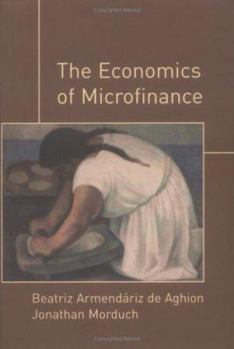The Economics of Microfinance
Select Format
Select Condition 
Book Overview
The microfinance revolution, begun with independent initiatives in Latin America and South Asia starting in the 1970s, has so far allowed 65 million poor people around the world to receive small loans without collateral, build up assets, and buy insurance. This comprehensive survey of microfinance seeks to bridge the gap in the existing literature on microfinance between academic economists and practitioners. Both authors have pursued the subject not only in academia but in the field; Beatriz Armendariz de Aghion founded a microfinance bank in Chiapas, Mexico, and Jonathan Morduch has done fieldwork in Bangladesh, China, and Indonesia. The authors move beyond the usual theoretical focus in the microfinance literature and draw on new developments in theories of contracts and incentives. They challenge conventional assumptions about how poor households save and build assets and how institutions can overcome market failures. The book provides an overview of microfinance by addressing a range of issues, including lessons from informal markets, savings and insurance, the role of women, the place of subsidies, impact measurement, and management incentives. and Latin America and introducing ideas about asymmetric information, principal-agent theory, and household decision making in the context of microfinance. The Economics of Microfinance can be used by students in economics, public policy, and development studies. Mathematical notation is used to clarify some arguments, but the main points can be grasped without the math. Each chapter ends with analytically challenging exercises for advanced economics students.
Format:Hardcover
Language:English
ISBN:0262012162
ISBN13:9780262012164
Release Date:January 2005
Publisher:MIT Press (MA)
Length:346 Pages
Weight:1.40 lbs.
Dimensions:1.0" x 6.4" x 9.2"
Customer Reviews
5 ratings
An eye opener
Published by Thriftbooks.com User , 17 years ago
To those that, as i am, have an Economics background and are just grasping the all immense universe that microfinance is becoming, this book opens perspectives and clears some very important issues. Issues such as the value of interest charging or the many different ways there actually are to build a microfinance initiative or the value of professional dedication to make it an effective and efficient working and sustainable intervention ... A must have!
Great book for self-teaching
Published by Thriftbooks.com User , 17 years ago
After reading "Banker to the Poor," I was interested in getting a bit more of an unbiased view of the subject of microfinance. The authors' views are clear and concise about each topic, plus they offer lots of other sources for the information. While it is obviously intended as s textbook, this book is a great way to teach yourself about the theory and empirical studies about microfinance. I could not have chosen a better book than this one.
Microfinance at its finest
Published by Thriftbooks.com User , 18 years ago
Microfinance is one of the newest strategies for development and Princeton economist Morduch takes a look at how it impacts societies. While he only looks briefly at the social issues he makes several compelling economic arguments for why we should consider microfinance as a viable option. The book is very well written although I think it does leave out some of the long term structural and institutional changes that need to be addressed. This is a field where new research comes out every day but Morduch's book is likely to be a staple for a very long time. This is a must have for anyone studying microfinance and will be for a long time to come.
The authoritative source on microfinance
Published by Thriftbooks.com User , 18 years ago
I've consulted a number of books on microfinance and found this to be one of the most intelligent, cogent sources of info on the field. Particularly impressive is the clearly written, even handed views on oft debated subjects (e.g. the role of subsidy in microfinance). Highly recommended.
Essential reading for development economists
Published by Thriftbooks.com User , 19 years ago
Microfinance has become one of the most important mechanisms for the development of informal business in developing economies. As such, it has attracted attention from development practitioners, economists and politicians. Disappointingly, most books on the subject can be best described as infomercials - rarely do they go beyond success stories of happy women in brightly coloured clothes who are now running home enterprises. But practitioners know that there is far more to microfinance than simply providing loans - just as there is far more to development than simply pouring money into a country. There are pitfalls to microfinance: it can crowd out local business, it can catapult poor people further into poverty if incorrectly adminstered, and there are a host of governance issues surrounding it. This book provides a comprehensive analysis of the economics of microfinance, as the title suggests. It is a technical book: it expects a high level of economic understanding, but it synthesises a vast amount of information on the subject and communicates it succintly. This is without a doubt one of the best technical economics books I have read - and I have read an awful lot of them. I've given this book to my PhD students working in this area as essential background reading before they commence research. I commend this book to any economist or development practitioner who is interested in the economics behind the stories and photos, who want to find solutions that will really catalyse economic development, who want to see successful projects implemented and who want to learn from the expertise of others to make sure they do the best for their clients.





